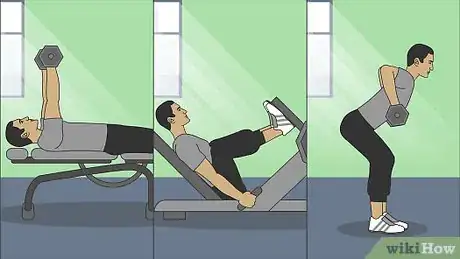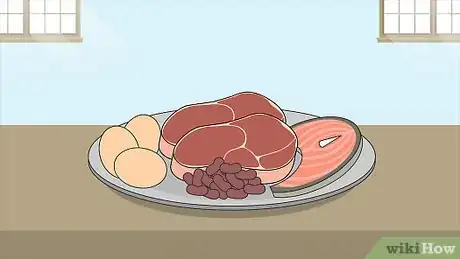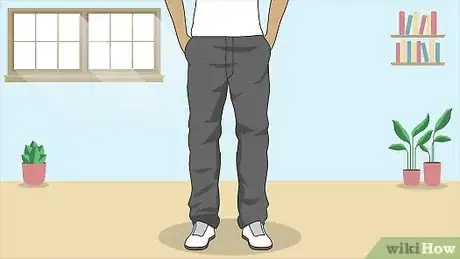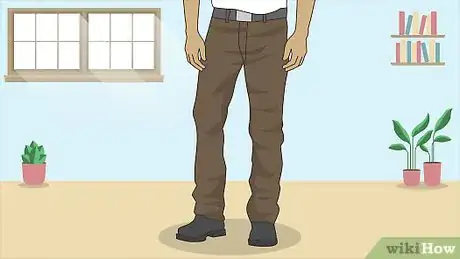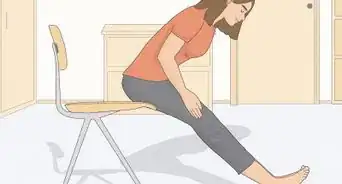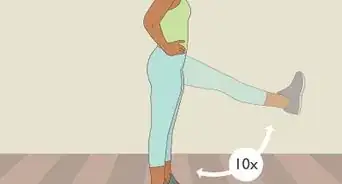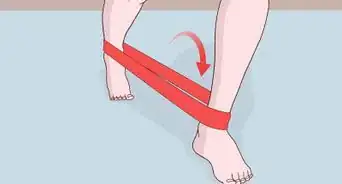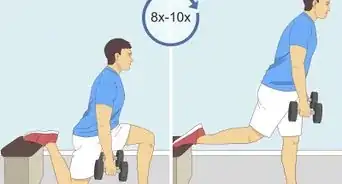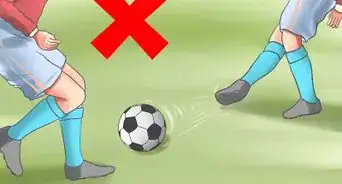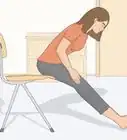This article was co-authored by Danny Gordon and by wikiHow staff writer, Dan Hickey. Danny Gordon is an American College of Sports Medicine (ACSM) Certified Personal Trainer and Owner of The Body Studio for Fitness, a fitness studio based in the San Francisco Bay Area. With over 20 years of physical training and teaching experience, he has focused his studio on semi-private personal training. Danny received his Personal Trainer Certification from the California State University, East Bay and the American College of Sports Medicine (ACSM).
There are 15 references cited in this article, which can be found at the bottom of the page.
This article has been viewed 1,935,492 times.
Let’s face it—leg day is not most people’s favorite day at the gym. It’s easy to get caught up in how your biceps, chest, or abs look until you glance in the mirror and notice your lower half is looking a bit underdeveloped in comparison. Whether you’ve got thin legs from your genetics or from skipping one too many leg days, we’ve got you covered. In this article, we’ll show you the best exercises to grow your leg muscles fast, plus the right diet to support your thick-thighed goals. Let’s take a look!
Things You Should Know
- Do squats, lunges, box jumps, and deadlifts (or use machines for moves like leg curls and leg presses) to build leg muscles. Aim for 3 sets of 8-12 reps per lift.
- Eat 5-10% more calories than you burn per day to encourage muscle growth, including about 0.8 grams of protein per pound of bodyweight (1.7 g per kg) per day.
- To hide skinny legs with clothing, wear slightly baggy pants to add some bulk to your lower half, and make sure shorts are somewhat fitted and not too loose.
Steps
Best Exercises for Leg Gains
-
1Do squats with dumbbells to build bigger thighs. If skinny thighs are your problem, this exercise is for you. Squats are a good way to pump up your thighs, and adding dumbbells or a barbell makes the exercise even more effective. Start with dumbbells you can lift 10 times without needing a break (10-20 pounds (4.5-9 kg) is a good starting weight for beginners).[1] To squat safely:
- Stand with your feet shoulder-width apart and your hands grasping dumbbells at your sides (or holding a barbell behind your head or at your chest).
- Bend your knees and lower your butt towards the floor in a squatting position.
- Hold your back straight and squat until your thighs are parallel to the floor. Keep your knees straight above your feet (don’t let them go past your toes).
- Push back up to your starting position.
- Repeat for 3 sets of 10-12 squats.
-
2Perform lunges with dumbbells. This exercise works your glutes, quadriceps and hamstrings, giving you a full-leg muscle workout. Try it without weights to get the form down if this is a new move for you, then add weights when you’re comfortable to build bigger legs.[2] To do lunges:
- Stand with your feet shoulder-length apart, and hold your dumbbells at your sides. If it’s more comfortable, hold them at your shoulders instead.
- Take a big step forward with one foot, dropping your opposite knee toward the floor (if you’re stepping with your right foot, drop your left knee toward the ground and vice versa).
- Keep your torso vertical to the ground with your knees aligned over your feet. Do not move the knee beyond your toes.
- Rise back to the starting position and immediately step forward with the opposite foot.
- Aim to do 3 sets of 15 reps. Once you have mastered this exercise, try increasing this to 4-5 sets of 10-12 reps with heavier weights.
Advertisement -
3Do box jumps to increase muscle in your calves. Grab a sturdy box or exercise step that won’t slip when you jump on it. The taller the box, the more difficult the exercise will be. Work without dumbbells or barbells for this exercise, since you might need your hands to catch you if you trip.[3] To box jump properly:
- Stand in front of the box with your toes pointed toward it.
- Jump explosively upward and land on the balls of your feet on the top of the box.
- Jump back down to the starting position.
- Work your way up until you are able to do 3 sets of 15 reps. Eventually, you may be able to do 4-5 sets of 10-12 reps.
-
4Add deadlifts to work your glutes and hamstrings. Load a barbell with an amount of weight you can lift for 10 reps without stopping to rest. If you don’t have a barbell, use two dumbbells that add up to the equivalent weight. Then, to safely pick up the barbell or dumbbells, bend your knees while keeping your back straight, and engage your abdominal muscles.[4] To deadlift:
- Stand with your feet shoulder-width apart. Place the barbell or dumbbells in front of you.
- Once you’ve picked up the weights, stand while hinging your hips forward. Keep your back straight and your abs contracted as you stand. Once you’ve risen, the weights will be at thigh-height.
- Bend again to lower the weight back to the floor.
- Repeat for 3 sets of 10-12 reps.
-
5Use leg exercise machines for moves like leg extensions and leg curls. Exercise machines allow you to gradually add more weight, target individual muscles, and increase the intensity of your workouts to promote muscle growth. For each exercise, start with the amount of weight you can lift with your legs 8-10 times before you need to stop. If needed, work with a trainer at your gym to determine the right weight for you.[5] Try:
- Leg extensions (quads): Sit on the leg extension machine with your knees bent and your feet under the lower bar. To lift the weight, straighten your legs but keep a slight bend in the knee. Hold until you feel the burn in your quads, then lower the weight back to starting the position. Do 3 sets of 10-12 reps.
- Standing leg curls (hamstrings): Load the leg curl machine with weight, then attach the cable to your ankle and hold the support bar with your hands. Bend your knee toward your butt to lift the weight, then straighten it back to the starting position. Do 3 sets of 10-12 reps per leg.
- Leg press (full leg): Load the weight rack and sit down, keeping your back pressed against the back of the seat. Plant both feet firmly on the weight plate and press the plate forward or upward, depending on the orientation of the machine. Aim for 3 sets of 8-10 reps.
- Calf raises (calves): Look for a seated calf raise machine and add weight. Sit down and place your knees under the padded bar with your feet planted on the floor, then raise your heels to move the weight. Go for 3 sets of 15-20 reps.
Adjusting Your Workout & Diet Regimen
-
1Limit cardio training to no more than 3 hours per week. Some cardio is essential to your health, but too much can actually make your legs more slender. For balance, do cardio with some resistance to help build leg muscle and contribute to your overall fitness. Try swimming, running or biking uphill, or hiking to increase your lower body strength.[6]
- Try working in 3-4 cardio sessions per week that last about 30 minutes (preferably on rest days and never right before a lifting session—you need your energy!).
-
2Aim for 2-3 sets of 8-12 reps with heavy weights for most leg lifts. Your legs are already used to working out all the time by carrying you everywhere you go. To encourage muscle growth, do high-intensity workouts using as much weight as you can while still keeping the correct form. If you can’t make it to 12 reps, stop the set once you hit exhaustion and give yourself about 30 seconds of rest between sets.
- Always focus on good form for safety and maximum gains—if you’re barely eeking out your 12th rep with improper form, it doesn’t count!
- Once you can move a certain weight for 3 sets of 12 reps, add more weight to continue developing strength and size. It may take a few weeks before you’re ready to increase the weight.
- Stop if you feel pain beyond the normal “burn” of a good workout. Injuries can bench you for weeks at a time and hinder your progress.[7]
-
3Do both fast, explosive movements and slow, controlled lifts. There’s lots of debate over which lift speed builds muscle mass the fastest, and the truth is that it varies for each person based on their goals and genetics. In general, slower lifts (up to 3 counts) put your muscles under tension longer and encourage growth (hypertrophy) and endurance. Faster lifts also build mass and can boost your power, too.[8]
- To develop your strength, endurance, and power alongside your leg size, alternate between workouts centered on slow lifts and ones focused on fast lifts.
- Experiment with both slow and fast lifts to see which triggers the most growth for your muscles. If you see better results one way or the other, stick with that method for most (but not every single) leg workout.
-
4Give your leg muscles 1-2 days of rest between workouts for recovery. Train other muscle groups on your off days, like your arms, chest, core, or back, to give your legs time to recover and actually grow. Hitting the same muscle group everyday can lead to fatigue or even injury.[9]
- On rest days, try low-impact activities like yoga or walking to keep your muscles engaged without pushing them too far.
- Aim to exercise your leg muscles 2-3 days per week to maximize growth and allow plenty of recovery time. A weekly routine might look like:
- Monday: Legs
- Tuesday: Chest and back
- Wednesday: Rest
- Thursday: Legs
- Friday: Arms
- Saturday: Core
- Sunday: Rest
-
5Eat a surplus of calories from nutritious, healthy food sources. When you’re working on building muscles, you need a calorie surplus (consuming more calories than you expend) for your muscles to grow larger. This doesn’t mean you should start gorging yourself on any old snack food, though. Instead, eat plenty of lean meat, tofu, whole grains, beans, fresh fruits and vegetables, and healthy fats like avocado or olive oil.[10]
- Limit processed foods, sugar and white flour, fast food, and snack foods. These leave you feeling tired instead of energetic and ready to work out.
- The exact number of calories you need depends on your current weight and muscle gain goals. For most people, eating 5-10% more calories than you burn in a day leads to muscle growth.[11]
-
6Eat 0.5-0.8 grams of protein per pound of bodyweight (1.2-1.7 g per kg) daily. Muscles grow when the amount of protein your body synthesizes per day is greater than the protein that it breaks down. Get the majority of your protein from lean meat sources like beef, chicken, pork, or fish, or from plant-based sources and dairy products like tofu, beans, quinoa, barley, eggs, cottage cheese, or yogurt.[12]
- For example, if you weigh 165 pounds (74.8 kg), you’d need between 82.5 and 132 grams of protein per day to build muscle
- Remember that protein only builds muscle when you’re also working out regularly. If you’re sedentary on a high-protein diet, you may start accumulating fat rather than muscle.
-
7Consider adding protein or pre-workout supplements to your diet. Supplements don’t work for everybody, but some find that they give their muscles an extra boost. If you’re thinking about trying a supplement, make sure to check the ingredients list for things you may be allergic to and consult your doctor just to be safe. Keep up your healthy workout routine, diet, and water intake, too—supplements alone won’t make your legs bigger.[13]
- Protein supplements, like protein powder, can help boost muscle mass gain over long periods when you’re consistently working out hard.[14]
- Pre- or post-workout supplements, like the amino acid creatine, give your muscles extra energy when they build up in your body over time. The extra boost during your workouts can help stimulate muscle growth.
- Only take the recommended amount of your supplement product.
Dressing So Your Legs Look Bigger
-
1Wear baggy pants to add a little bulk to your leg line. Choose pants that are tailored well in the waist but hang a little loose around your legs, like straight-leg jeans. There are plenty of styles to choose from that make your legs look strong without drowning you in fabric. For example, boot-cut jeans hug your thighs and flare at the knee, making your legs look a bit thicker.[15]
- Steer clear of skinny jeans or really tight pants, which emphasize the thinness of your legs.
-
2Wear boots underneath your pants. This look is always in style and it can make your legs (especially the calves) look thicker or more muscular. Choose boots that rise midway up your calves and wear a pair of boot-cut jeans over them.[16]
- Also consider tucking your pants into tall boots to make your calves appear thicker.
-
3Choose tailored or close-fitting shorts over baggy ones. Loose, baggy, or oversized shorts highlight the small circumference of skinny legs. Go for shorts that hug your thighs more closely to make them appear thicker or like they’re “filling out” the shorts more.[17]
-
4Play with pastel colors or bold prints to make your legs look larger. While dark colors like black or navy are slimming, bright colors or pastels like lavender, mint, powder blue, or light pink draw more attention and create the illusion or larger size. Bold patterns like wide, horizontal stripes or abstract designs can also add bulk to your lower half.[18]
Expert Q&A
-
QuestionHow do I get rid of fat on my knees?
 Michele DolanMichele Dolan is a BCRPA certified Personal Trainer in British Columbia. She has been a personal trainer and fitness instructor since 2002.
Michele DolanMichele Dolan is a BCRPA certified Personal Trainer in British Columbia. She has been a personal trainer and fitness instructor since 2002.
Certified Fitness Trainer Fat around the knees cannot be lost selectively. To lose fat from anywhere, you will have to lose fat from everywhere. A reduced calorie diet and exercise 5-6 days per week is the only way to lose fat from a specific place barring liposuction.
Fat around the knees cannot be lost selectively. To lose fat from anywhere, you will have to lose fat from everywhere. A reduced calorie diet and exercise 5-6 days per week is the only way to lose fat from a specific place barring liposuction. -
QuestionI'm a senior and can't do weights. I have skinny legs and would like to put some weight on my legs.
 Michele DolanMichele Dolan is a BCRPA certified Personal Trainer in British Columbia. She has been a personal trainer and fitness instructor since 2002.
Michele DolanMichele Dolan is a BCRPA certified Personal Trainer in British Columbia. She has been a personal trainer and fitness instructor since 2002.
Certified Fitness Trainer Try walking uphill or cycling up hills. If you golf, try pulling your own clubs on a cart. That will build muscle.
Try walking uphill or cycling up hills. If you golf, try pulling your own clubs on a cart. That will build muscle. -
QuestionHow many times a week should I do these work outs?
 wikiHow Staff EditorThis answer was written by one of our trained team of researchers who validated it for accuracy and comprehensiveness.
wikiHow Staff EditorThis answer was written by one of our trained team of researchers who validated it for accuracy and comprehensiveness.
Staff Answer wikiHow Staff EditorStaff AnswerTo build noticeable muscle mass in your legs, try to do a leg routine 2-3 days a week. Give yourself a day or 2 between each leg day so your muscles have time to recover and grow.
wikiHow Staff EditorStaff AnswerTo build noticeable muscle mass in your legs, try to do a leg routine 2-3 days a week. Give yourself a day or 2 between each leg day so your muscles have time to recover and grow.
References
- ↑ https://hr.duke.edu/wellness/runwalk-club/training-education/strengthen-your-legs
- ↑ https://hr.duke.edu/wellness/runwalk-club/training-education/strengthen-your-legs
- ↑ https://www.muscleandfitness.com/workouts/legs-exercises/box-jumps
- ↑ https://stronglifts.com/deadlift/
- ↑ https://www.yourworkoutbook.com/best-leg-machines-at-the-gym/
- ↑ https://aaptiv.com/magazine/cardio-for-weight-lifters/
- ↑ https://www.mayoclinic.org/healthy-lifestyle/fitness/in-depth/weight-training/art-20045842
- ↑ https://www.gq.co.za/culture/fitness/muscle-building-are-slow-or-fast-reps-better-1cbf3783-58b4-4260-969a-e38e48591e85
- ↑ https://www.colorado.edu/today/2018/11/13/healthy-buffs-making-gains-your-rest-days
- ↑ https://www.verywellfit.com/are-you-eating-for-muscle-3121316
- ↑ https://powerliftingtechnique.com/how-many-calories-should-i-eat-to-gain-muscle/
- ↑ https://www.acsm.org/docs/default-source/files-for-resource-library/protein-intake-for-optimal-muscle-maintenance.pdf
- ↑ https://www.hsph.harvard.edu/nutritionsource/workout-supplements/
- ↑ https://pubmed.ncbi.nlm.nih.gov/25169440/
- ↑ https://www.fabulousafter40.com/what-to-wear-when-you-have-skinny-legs/
- ↑ https://www.fabulousafter40.com/what-to-wear-when-you-have-skinny-legs/
- ↑ https://dapperlydressed.com/how-to-wear-shorts-with-skinny-legs/
- ↑ https://www.fabulousafter40.com/what-to-wear-when-you-have-skinny-legs/
About This Article
If you want bigger legs, try an exercise regimen designed to target your lower body. Each day, perform 3 sets of 10-12 squats per day to build up your thighs, and do 3 sets of 15 forward lunges for bigger quads and glutes. You can intensify both of these exercises by adding dumbbells to the workout. Box jumps will help you build up your calves, but don’t use dumbbells during this exercise in case you trip. Keep reading for tips on using clothes to make your legs look bigger!


